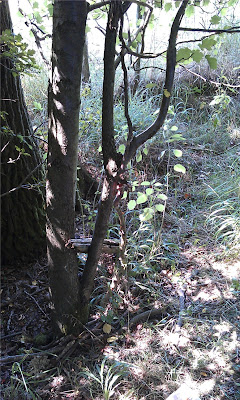Meadowcopse recently posted an extract http://www.swog.org.uk/forum/viewtopic.php?f=7&t=1727#p10351 about Wild Service Tree distributions in the UK. We are right in the "Western Weald" clay area that is mentioned ( indeed, if you dig down just about half a meter in our wood you do hit some pure light grey clay) and the article describes Wild Service Trees as "well established at low concentrations" in this area.
We have three of them and, naturally, I want to look after them and wondered if anyone had any thoughts on this?
One of the trees is mature and large but, sadly, only has one bough left on it, nearly vertical and reaching 20 to 25 meters to the very top of the canopy. Here is a stitched together , pseudo wide-angle, photo of the whole tree.....
Presumably the reason this bough has survived where all others failed is because it is near vertical and supports it's own weight. It has survived the recent high winds but I fear that one day I'll go there and find this last bough snapped off due to the 'windsail' factor. Presumably that would be the end of the tree if that did happen...?
The trunk is in great condition. I don't see any holes, splits, decay or that kind of thing
Then there are two younger trees, both about 4" diameter and about 4 metres high. They are 20 metres and 30 metres to the north of the mature tree and they are both growing within a thin hedgerow.
I guess that these two trees came from seed/fruit dispersed from the larger tree; the article talks about new trees commonly forming from suckers but surely not the case here where they are 30 meters away ...
Bizarrely, each of them is growing just several inches away from a mature oak tree. Here's a picture of one of them with its oak tree just behind it.

The article mentions that Wild Service trees do not compete well with oak, and other, trees and that when overshadowed by faster growing trees they will not produce flower/fruit. Is there a case here for having the two oaks felled for their benefit I wonder ?
However that article does also also say that flower and fruit production is dependent on warm summers and that even in drier and warmer parts of Britain it may only fruit every other year, or less. We did not see any flower/fruit on our trees in 2013 but maybe we should wait and see....?
Finally, I've been thinking about physical protection for the young trees. They are in a thin hedgerow and so a little exposed to possibility of damage from deer that are often roaming the wood. The deer have left them alone so far but maybe we've just been lucky. We did have some horses get into the wood and they had a nibble on one of the young trees. So I was thinking to perhaps put a line of brash or some fence around, or alongside, this part of the hedgerow to make sure no large animals could get to them.
The other option is that these three trees have survived this far without any interference from me so perhaps I should just leave them alone / leave it to nature ...
Thanks
